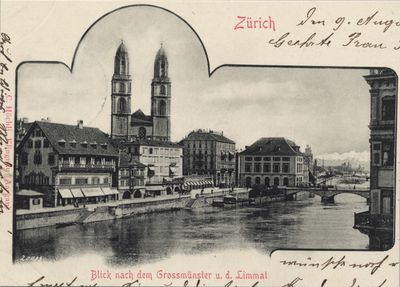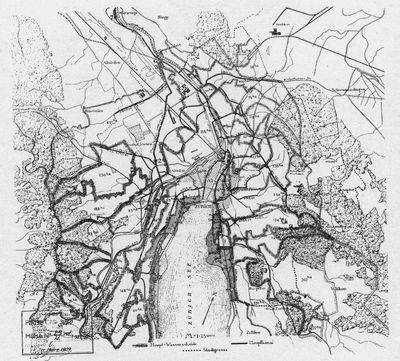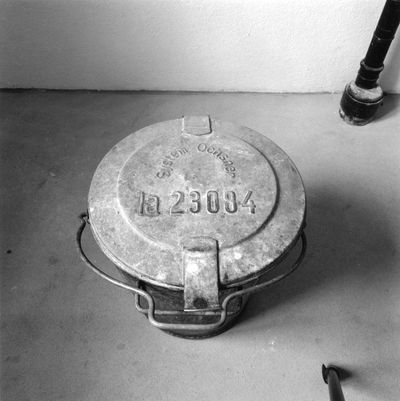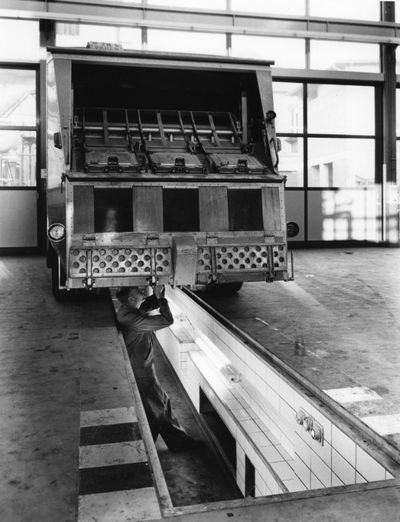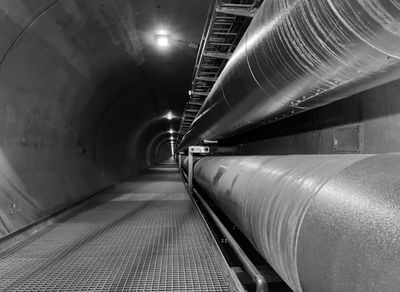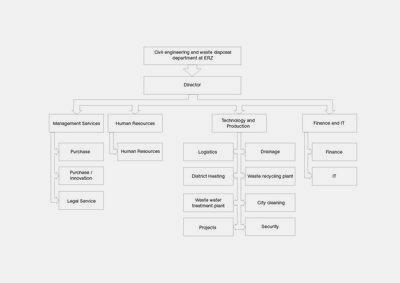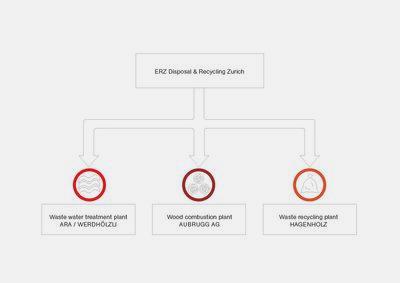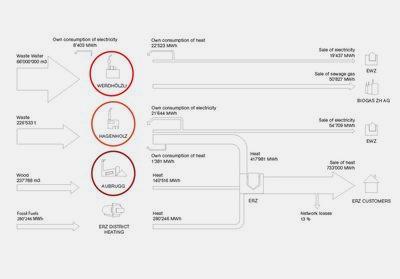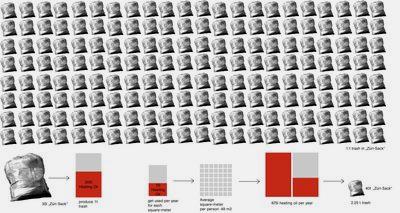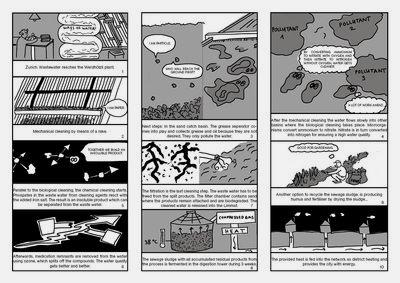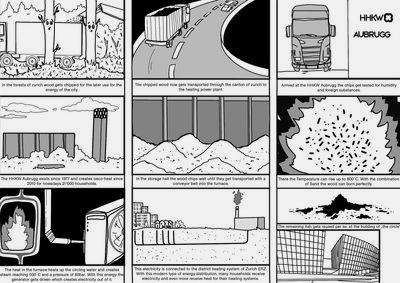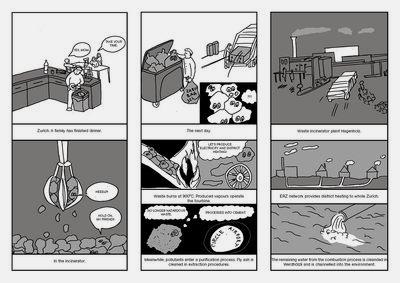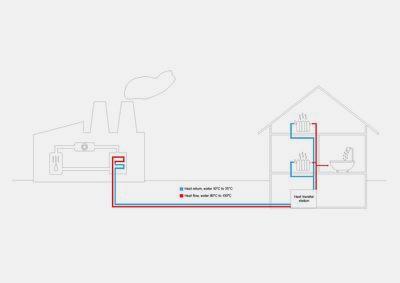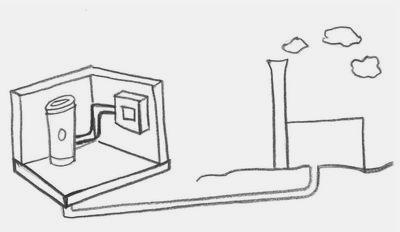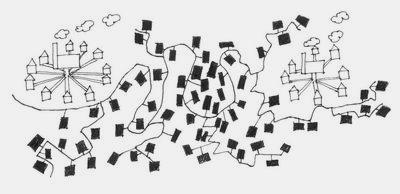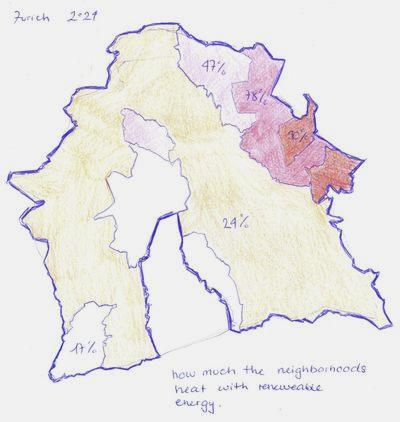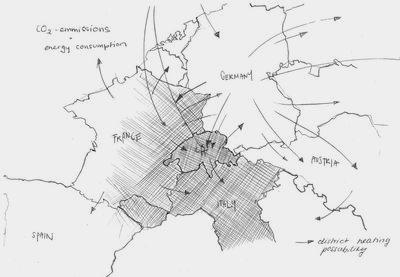AtlasWaste & Wood and ERZNour Ben M’barek and Catia Marcotullio
From the Skip Bin System to ERZ
The development of waste infrastructure dates back to the beginning of the 19th century. The first sewers serve as drainage in the city of Zurich. The role of the river Limmat is crucial. This is because the wastewater is channelled directly into the Limmat. The faeces are collected in buckets, which is referred to as a so-called “discharge bucket system”. The buckets are removed by the collection system. Waste collection is organised in the city as well as in the suburbs. Waste is transported by horse and cart.
FROM 1900
What changes over time? The sewer network grows to 180 kilometres. The first waste incineration plant is set up in Josefstrasse. The company’s waste collection system is continually expanded and refined.
Not only are the horse-drawn vehicles steadily replaced by cars, but the quality of the bins is also improved. The standardised waste bin called the Ochsner bin, made of metal, is a prime example of this. In 1928, the first district heating network was established, using heat from Josefstrasse to supply the main railway station and the Sihlpost. More and more housing estates began to be integrated into the network.
From 1950
Wastewater treatment is expanded. The sewerage network expands to 745 kilometres. Hagenholz as a further waste recycling plant alongside Josefstrasse and the wood-fired power station in Aubrugg become part of the district heating network.
In the 1980s, the city threatens to drown in waste. The situation is alleviated when the first collection and recycling centres are set up and the rubbish bag charge is introduced. At the end of the 1990s, waste collection and urban drainage are merged. ERZ is created, in parallel with Fernwärme Zürich. Fernwärme Zürich is formed by the city, the canton and ETH. However, it quickly becomes part of ERZ.
From 2000
The ERZ network grows and incorporates more and more companies, such as the workshops of the civil engineering office. The facility in Hagenholz is modernised in the meantime. ERZ continues to play an increasingly important role in the city of Zurich. The methods for professional waste utilisation are being refined.
The facilities are technologically modernised, as is the flue gas cleaning system in Hagenholz. Vegetable garden and kitchen waste and food waste are now also included in the recycling process. In Werdhölzli, a central sewage sludge utilisation plant is provided by the ERZ. In 2016, the waste recycling process will be improved by enabling metal recovery by means of dry discharge. At the same time, Zurich is introducing a new drainage plan. Changes need to be made in order to meet future changes and climate targets. At the same time, district heating is being expanded, which is approved by 83 per cent of the electorate. A new connecting tunnel is being built at Milchbuckstrasse, which will distribute the heating water from Hagenholz to Zurich-West and guarantee the heat supply. In 2021, the Josefstrasse waste incineration plant is disconnected from the grid after more than a hundred years of operation.
ERZ'S Power Structures in Zurich
ERZ, which stands for “Entsorgung und Recycling Zürich”, is organised into various departments. There is a clear hierarchy. It is a service department within the Department of Civil Engineering and Waste Management of the City of Zurich. The most important tasks include keeping public spaces clean, waste disposal and recycling, water and waste water and district heating production. The organisation is constantly expanding its areas of activity and is focusing on achieving climate targets as well as net-zero strategies for the year 2040.
High Ambitions
ERZ utilises environmentally friendly primary energies, namely the waste heat from the two waste incineration plants Hagenholz and Josefstrasse, and supplies the heat in the form of water heated to 90 to 120 °C directly to the buildings via a network of pipes. A convincing heating solution for heating, cooling and hot water preparation is offered in five supply areas. The current district heating network can heat around 170,000 homes, with two thirds of the heat produced being CO2-neutral.
At over 160 kilometres, Zurich’s district heating network is the second longest in Switzerland. The connection between the Zurich North and Zurich West district heating networks has been completed. The first newly connected properties are already receiving climate-friendly district heating from ERZ. The development of additional neighbourhoods should avoid thousands of tonnes of CO2 emissions.
A Minor Debacle
All that glitters is not gold. ERZ has also had some difficult times. In December 2015, it came to light that additional costs of CHF 15 million had been covered up during the construction of a new logistics centre. In addition, the director at the time, Urs Pauli, bought himself an expensive luxury car that he used as a company car. He not only made dirty deals with cash totalling 200,000 Swiss francs, but also used his position of power to his advantage. He managed ERZ on his own authority. Business reports remained opaque. Further investigations are still ongoing. But why did ERZ behave like a private company? At the end of the 1990s, Zurich’s waste management system was in a precarious state. Reorganisers from the private sector got the company back on track. They took responsibility and pulled the waste disposal system out of its misery. This led to a private-sector approach, even though the money came from tax revenues and fees from the population.
Who pulls the strings?
The City of Zurich and the Zurich City Council took out a loan totalling 330 million to drive forward the expansion of district heating. The ERZ is not a private company, but instead represents the energy centre at both cantonal and national level.
The energy policy in the city of Zurich is as follows: In May 2022, the electorate of the city of Zurich approved the new climate protection target: With net zero, Zurich will become climate-neutral by 2040. The city administration wants to achieve this goal by 2035. An effective energy policy is the basis for achieving this climate protection target. The City of Zurich’s energy policy guidelines are: sufficiency, efficiency and consistency. The order also reflects the priorities of the city’s energy policy: “Less, Better, Different”.
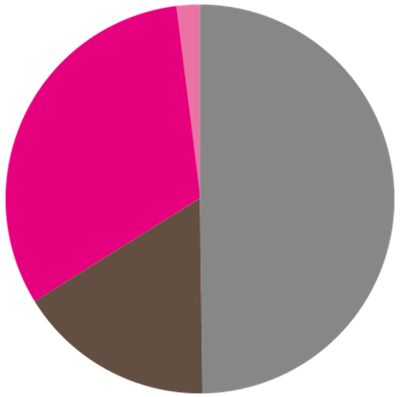
Energy mix for district heating. Source: Stadt Zürich, 2022.
- Waste (51 %)
- Wood (17 %)
- Natural gas (32 %)
- Heating oil (< 1 %)
Where the energy is produced
Energy is mainly drawn from the three power plants: Hagenholz, Aubrugg and Josefstrasse. ERZ has had a heat storage facility at the Hagenholz site since 2017. The water in the storage tanks is heated with surplus heat and fed into the district heating network to cover peak loads. By creating additional heat storage facilities of this kind, among other things, ERZ is pursuing the goal of operating district heating entirely without the use of gas or oil by 2040. District heating currently covers around 16 per cent of the city’s heating requirements. Following the expansion of the district heating supply, this share will rise to around 25 per cent. Compared to fossil fuels, ERZ district heating already saves over 200,000 tonnes of CO2 per year. After the expansion, it will be 236,000 tonnes of CO2 per year. By 2040, ERZ aims to completely dispense with the use of fossil fuels in district heating production. This is because they are currently sourcing natural gas from the North Sea and crude oil from the Arab region for fossil fuels. In order to achieve the climate target, it will be necessary to expand capacities for renewable heat generation and build additional heat storage facilities.
How waste can empower change
A lot of heating oil can be saved by burning waste. With 1 tonne of waste, it is possible to replace 300 litres of heating oil.
Tracking Energy
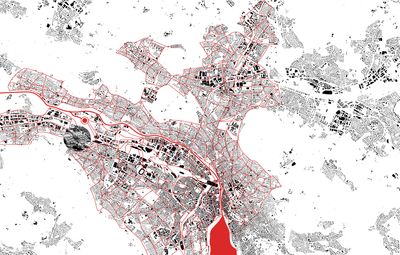
Waste water cleaning. Source: QGIS, 2020.
 waste water treatment plant Werdhölzli
waste water treatment plant Werdhölzli main sewage tunnel grid
main sewage tunnel grid

Wood combustion. Source: Stadt Zürich, 2022.
 Thermal wood power station Aubrugg
Thermal wood power station Aubrugg Forests of Zurich
Forests of Zurich Degradation of wood chips
Degradation of wood chips Reuse of the ash per ex at "The Circle"
Reuse of the ash per ex at "The Circle"
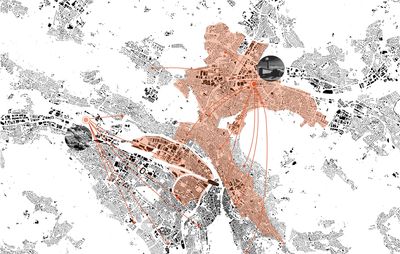
Waste recycling. Source: Thermische Verwertung, 2017.
 Incinerator Hagenholz
Incinerator Hagenholz District heating network Hagenholz
District heating network Hagenholz Recycling centre Werdhölzli
Recycling centre Werdhölzli Disposal points Zurich
Disposal points Zurich
The Visible Invisibility or Invisible Visibility?
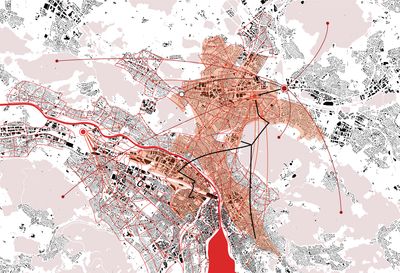
Overlapped infrastructures. Source: QGIS; Stadt Zürich, 2022.
The map shows only a fragment of the infrastructures found. In reality, the networks are much more interwoven and denser, such as the sewer network. The invisible structures such as pipes remain underground. By contrast, the visible ones, such as the waste disposal system, are so complex that they are only noticed in passing or only when they no longer function properly. The district heating network marked as black line in the map, represents the main pipes for providing the city with energy.
The Principle of District Heating
How it works
District heating is the heat generated during the waste incineration process in waste-to-energy plants. Not only is the volume of waste reduced by 90 per cent, but 70 per cent of the energy in the waste is converted into electricity and heat. This is done by the largest electricity producer, which is discussed in the second chapter, in Zurich. The heat they produce consists of a mixture of several energy sources. The most important source is the waste heat generated by the waste incineration plants. On average, this waste heat covers two thirds of the total demand of all buildings connected to the grid. In this way, energy is produced in a CO2-neutral and climate-friendly way, as less heating oil and therefore fossil fuels are consumed each year. It is only in winter that additional fossil fuels are used to cover the high electricity demand caused by heating.
There are several production plants in Zurich that can provide sufficient waste heat: There are two waste-to-energy plants. One of them is Hagenholz, the other is Josefstrasse. Hagenholz accepts waste from companies, municipalities and private individuals. The Josefstrasse plant, which is considered the oldest waste incineration plant in Switzerland, has only been utilising imported waste from southern Germany since 2011. It is important to know that waste, regardless of where it comes from, is incinerated around the clock. The Aubrugg wood-fired power plant is also important as an energy supplier. In winter, the boilers come into play, generating additional waste heat from fossil fuels such as heating oil or gas. The heat is transported to the customers via underground pipes using water and fed into the circuit. The colder return water flows back to the system.
Pros and cons
Maintenance and servicing are reduced because you generally no longer have to worry about chimney cleaning, flue gas measurements or ordering heating oil. Another point is space saving. The installed heat transfer station has a compact design and operates noiselessly. There is a high level of security of supply, because in the event of an outage, not everything collapses. You can fall back on the other heat sources. Energy sources can be shared, which would otherwise be impossible for a single building to utilise. District heating is a local energy source that is renewable. It contributes to “regional added value”. It also reduces CO2 emissions and makes a significant contribution to climate friendliness.
However, the further the district heating network is expanded, the longer the distances that the heat has to travel from the plant to the customer. Network expansion leads to greater heat losses due to the transport route in the network itself. In other words, the size of the network has an influence on efficient heat distribution. This means that if there are many small customers who require many more pipes for heat consumption, the losses are correspondingly greater than for a single industrial company, for example.
The Future Energy Debate: Utopia or Dystopia?
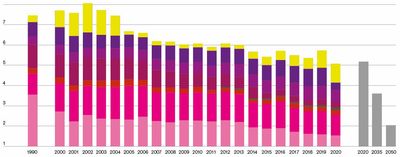
Development of emissions. Source: Stadt Zürich, Treibhausgasbilanz, 2020.
- Wood and environmental heat
- District heating
- Natural gas
- Heating oil
- Targets according to energy masterplan
Greenhouse gas emissions in the city of Zurich have decreased significantly since 1990. On average over the last five years, the city’s inhabitants have released around 4.3 tonnes of greenhouse gases per person per year. This is around 1.9 tonnes less than in 1990. The main part of the reduction in greenhouse gas emissions lies in the building sector. On the one hand, the thermal refurbishment of buildings and the construction of new replacement buildings led to a reduction in heating requirements. On the other hand, the increased use of district heating and the replacement of oil heating systems with gas and heat pump heating systems contributed to a further reduction in greenhouse gas emissions from fossil fuels. Greenhouse gas emissions in the area of mobility fell slightly in the city of Zurich between 1990 and 2020 – in contrast to Switzerland as a whole, where an increase continues to be recorded. Transport accounts for around 40 per cent of total greenhouse gas emissions in the city of Zurich. This means that mobility can and must play an important role on the road to the 2000-watt society.
2000-WATT SOCIETY AND DROWNING IN WASTE?
The city of Zurich has achieved some partial successes in its climate policy. For example, greenhouse gas emissions were reduced by around 30 per cent by 2020 compared to 1990. The city of Zurich is approaching its interim target for 2020 of 4 tonnes of greenhouse gas emissions per person per year, albeit still too slowly. In particular, the long-term target of 1 tonne by 2050 is a major challenge. Enormous efforts are required here. Measures must be taken in all energy-relevant sectors. As the City of Zurich’s room for manoeuvre is limited in some areas, for example in air traffic, fuel, electricity efficiency and heating replacement, the City of Zurich is dependent on corresponding efforts by the Canton of Zurich, the federal government and all residents. In addition to district heating, other heating systems such as heat pumps and lake heating also show great potential for the future. In the case of district heating, society tends to produce more waste. The population is growing and so is the amount of waste, which can have problematic aspects.
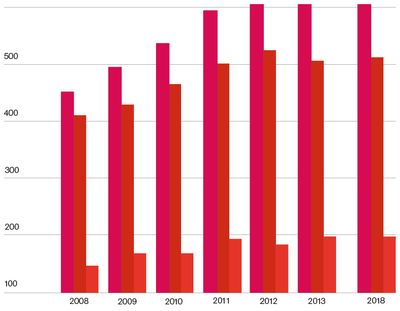
District heating demand grows: development of energy output (district heating) in MWh/a. Source: Thermische Verwertung, 2017.
- Total
- Heat
- Electricity
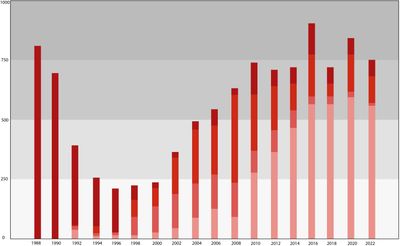
Waste evolution. Source: Stadt Zürich, 2022.
- Heavily charged waste
- KVA: Slag
- Heavily charged inorganic waste
- Slightly charged mineral waste
Central dependency can be favourable because the provider company ensures security and stability. Nevertheless, if something in the system fails, everything is paralysed at once.
The individualistic aspect of whether you can actually produce energy yourself, as with solar collectors for example, has two sides. On the one hand, you can store the extra energy for yourself with heat accumulators in the house. On the other hand, some of it flows back to the supplier. You will never completely get rid of this dependency.
No, according to the law it is strictly forbidden to burn one’s own waste in the garden. This is a criminal offence.
The denser the city becomes, the more you have to refine the network to be able to connect every house. The network thus becomes larger. The geographical locations of the systems have to be taken more into account and a more decentralised approach has to be applied. Decentralised approaches can be worthwhile because not everything goes out at once in an emergency. However, this can lead to greater heat losses in the lines due to the longer transport routes in the extended network. Therefore, energy compounds can be very helpful in connecting neighbourhoods with each other in an energy-efficient way.
Dirty energy mixes
The composition of the electricity mix has changed significantly in recent years. Since 1 January 2015, the municipal electricity utility EWZ has been supplying all households and private customers who cannot choose their own electricity provider exclusively with electricity from 100 per cent renewable energy sources. Since 1 January 2020, business customers have also been supplied with electricity from 100 per cent renewable energy sources. As a result, the proportion of electricity from nuclear power has fallen from around 27 per cent (2014) to zero per cent (2020), while the proportion of electricity from hydropower has risen from around 60 per cent to around 70 per cent.
However, the positive effect of this greening of electricity products has been dampened by the liberalisation of the electricity market. Large customers are free to decide which supplier they wish to purchase electricity from. As only the quantity, but not the quality, of electricity that is not purchased from EWZ is known, the average electricity mix in the European market is used in the statistics. This contains a significant proportion of fossil-fuelled electricity from coal and gas-fired power plants. The “European electricity mix” share of total electricity consumption in the city of Zurich has risen continuously in recent years to over 20 per cent.
The population of the city of Zurich has set itself the goal of a 2000-watt society. The efforts are having an effect: energy consumption and greenhouse gas emissions have fallen in recent years. The current 2000-watt balance sheet shows: Zurich is on the right track. The city has reached its interim target for energy consumption by 2020. In terms of greenhouse gas emissions, Zurich is approaching the interim target, but still too slowly, as the current 2000-watt balance sheet from July 2021 shows. Conclusion: The city of Zurich is making good progress, but not yet good enough in the medium term. Major efforts are needed to drive forward further reductions.
Lake thermal energy is a way of expanding the principle of district heating. It is also an endeavour, because ultimately the aim is to dispense with fossil fuels.
Vast foreign networks: An European dependency
In the last five years, Switzerland has consumed an average of around 810,000 terajoules of energy per year and is around 70 % dependent on other countries for this. “Because the discussion in Switzerland always revolves around electricity, the general view is that we are much better than Germany, for example. However, this view is fundamentally wrong, as hydropower accounts for just over 20% of Swiss energy consumption,” says Stefan Batzli, Managing Director of the umbrella organisation for renewable energies and energy efficiency. New renewable energies account for just a few per cent in Switzerland. “Switzerland is far behind in the field of new renewable energy and is falling further and further behind,” says Batzli.
As far as electricity is concerned, Switzerland is one of the countries in Europe with the largest proportion of renewable energy sources. Around 60% of electricity is generated by the country’s more than 600 hydropower plants, many of which were built before the 1970s. In Switzerland, almost 65% of the energy consumed in Switzerland comes from fossil sources (oil and gas). The proportion of new renewable energy sources such as solar, wind and geothermal energy is 2.8 %, plus around 20% hydroelectric power.
The European electricity grid supplies over 30 countries with around 530 million consumers. Switzerland is part of this grid. It is currently connected to its neighbouring countries via 41 lines. Switzerland acts as a central hub in international electricity trading: On behalf of the European Network of Transmission System Operators for Electricity (ENTSO-E), Swissgrid is the coordination centre for Southern Europe. Switzerland also plays an important international role in technical terms: the “Star of Laufenburg” substation has been an important centre of the European electricity grid since 1958.
Hydropower generation is just as seasonal as electricity consumption. As a result, Switzerland is an electricity importer in winter and an electricity exporter in summer. To ensure security of supply, it is therefore essential that the Swiss electricity grid is connected to other countries. The Swiss transmission grid also plays an important role in transit between neighbouring countries; Europe is therefore dependent on the Swiss electricity grid.
Even without EU membership, Switzerland is therefore part of “Electricity Europe”. However, without an electricity agreement, this participation is limited to the technical aspects of the electricity grid – even though Switzerland is a full member of the ENTSO-E. However, as electricity trading with Europe is an important pillar of our efforts to achieve the urgently needed increase in supply-side system flexibility, the early conclusion of the electricity agreement between Switzerland and Europe is of the utmost importance with regard to grid stability and security of supply. Finally, Switzerland is completely dependent on other countries for gas: demand must largely be covered by imports.
The two projects “Switzerland and EU energy policy” and “Europeanisation of the Swiss energy system” have examined political and market-related aspects of the future relationship between Switzerland and Europe with regard to the Energy Strategy 2050. They show that the topic is very complex and has great significance for the Swiss electricity market.
